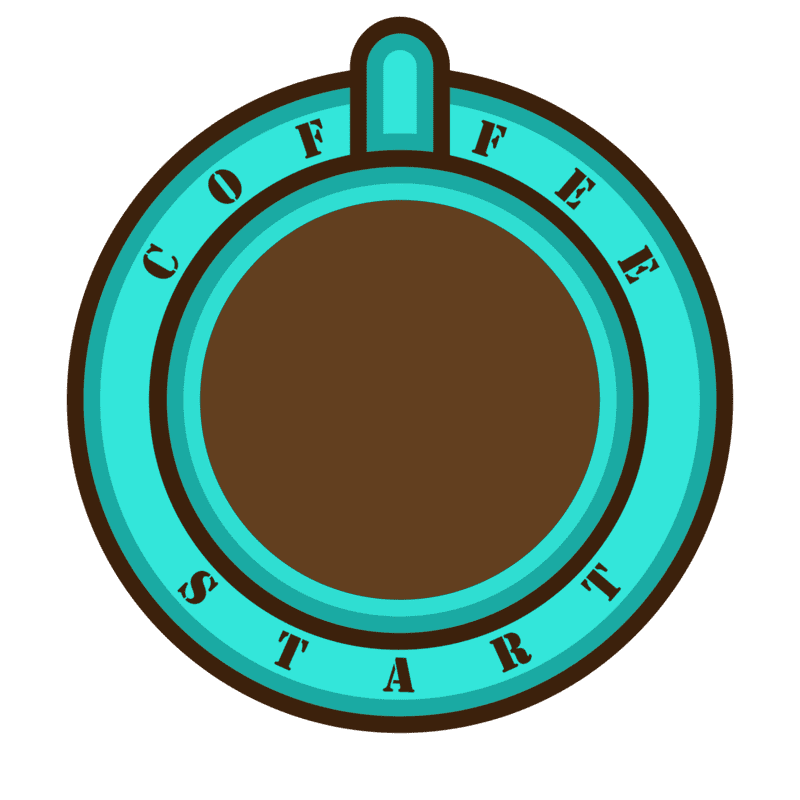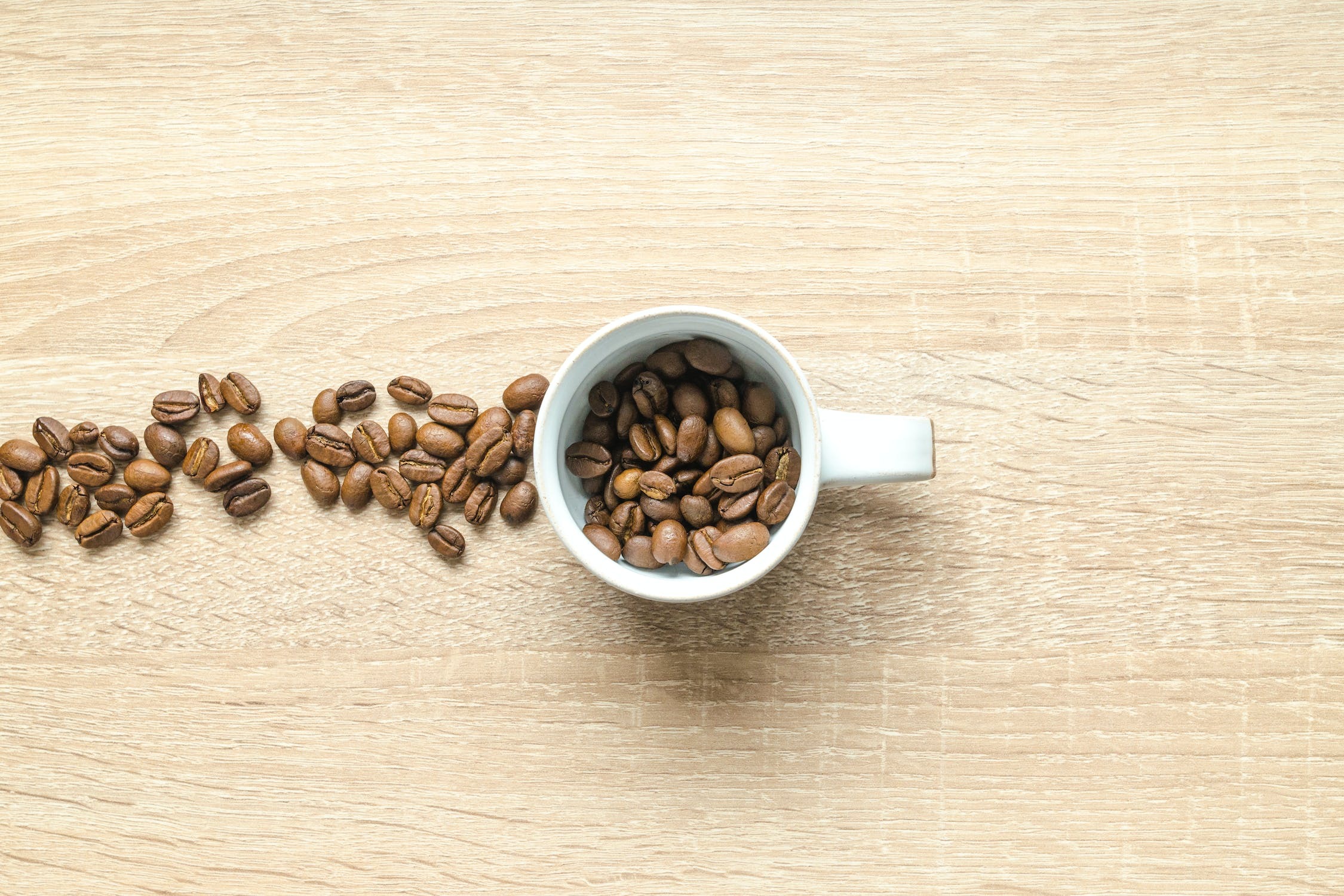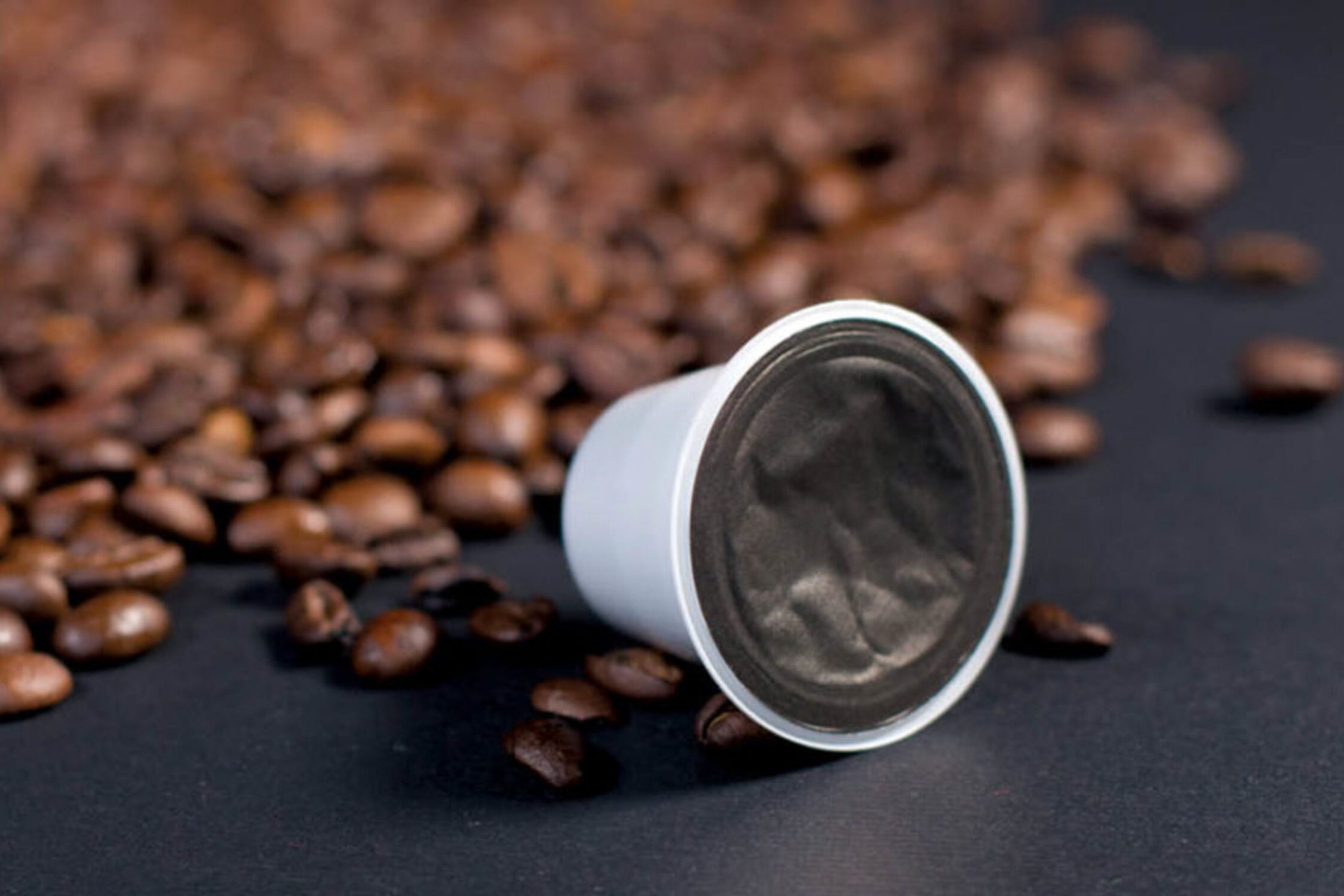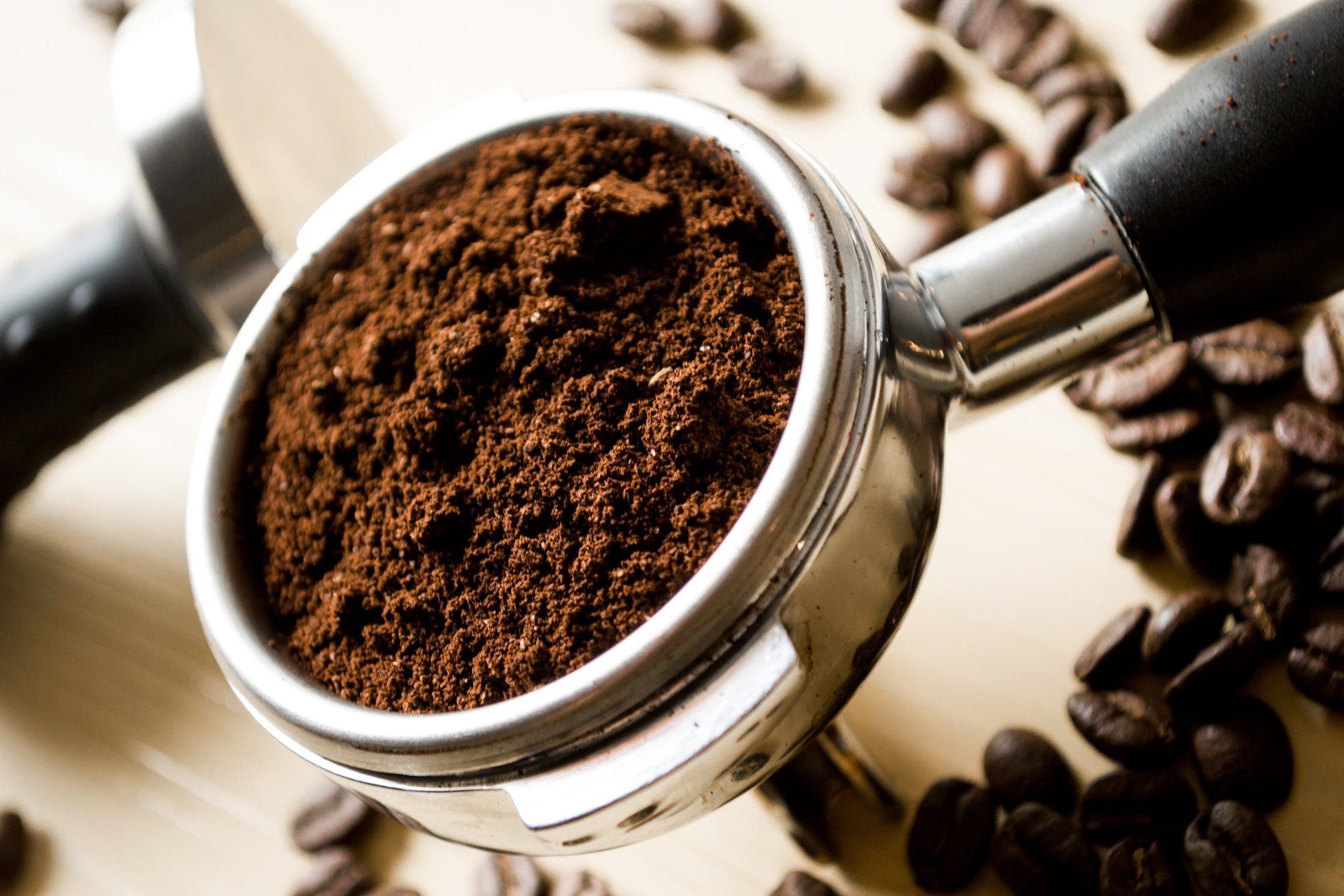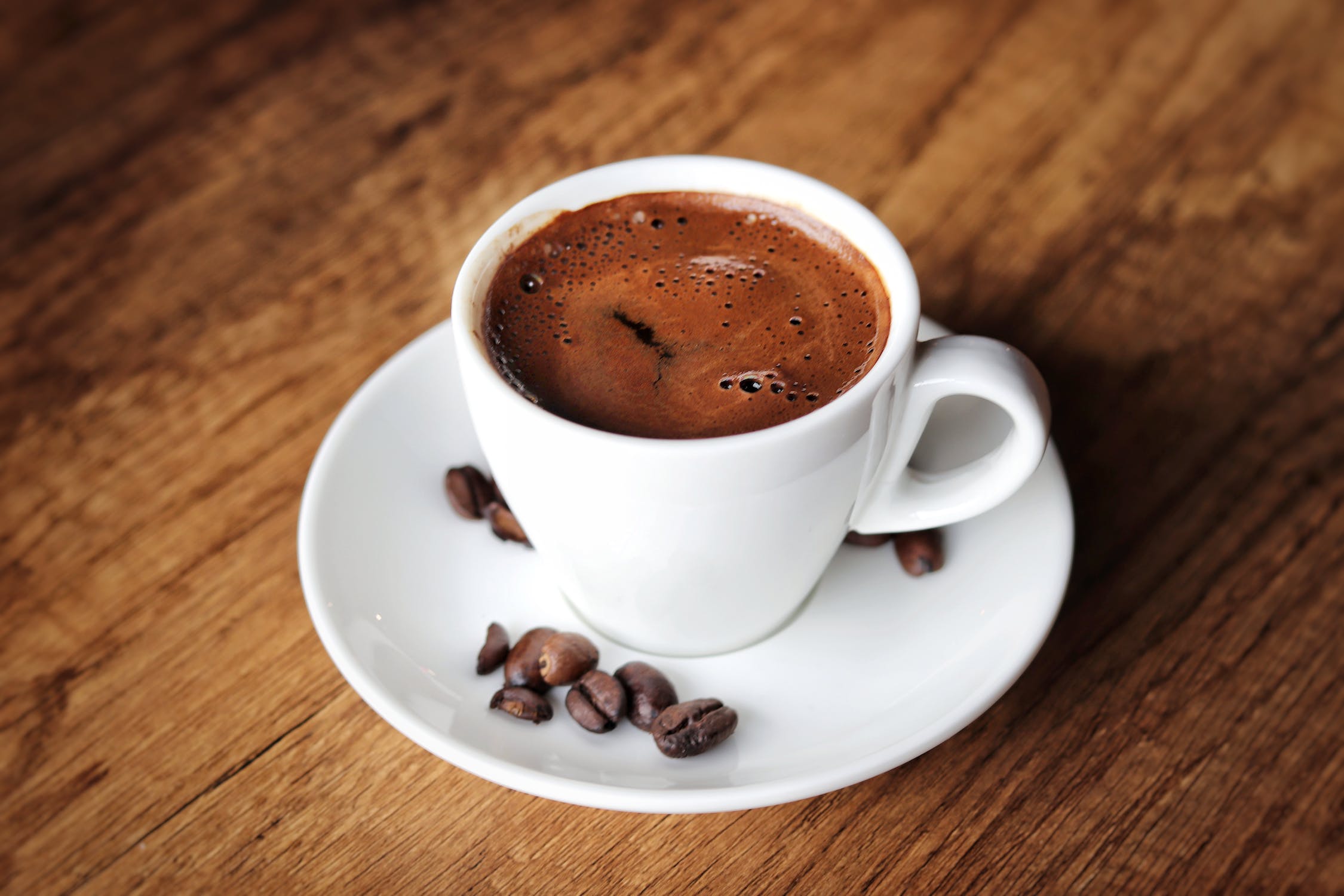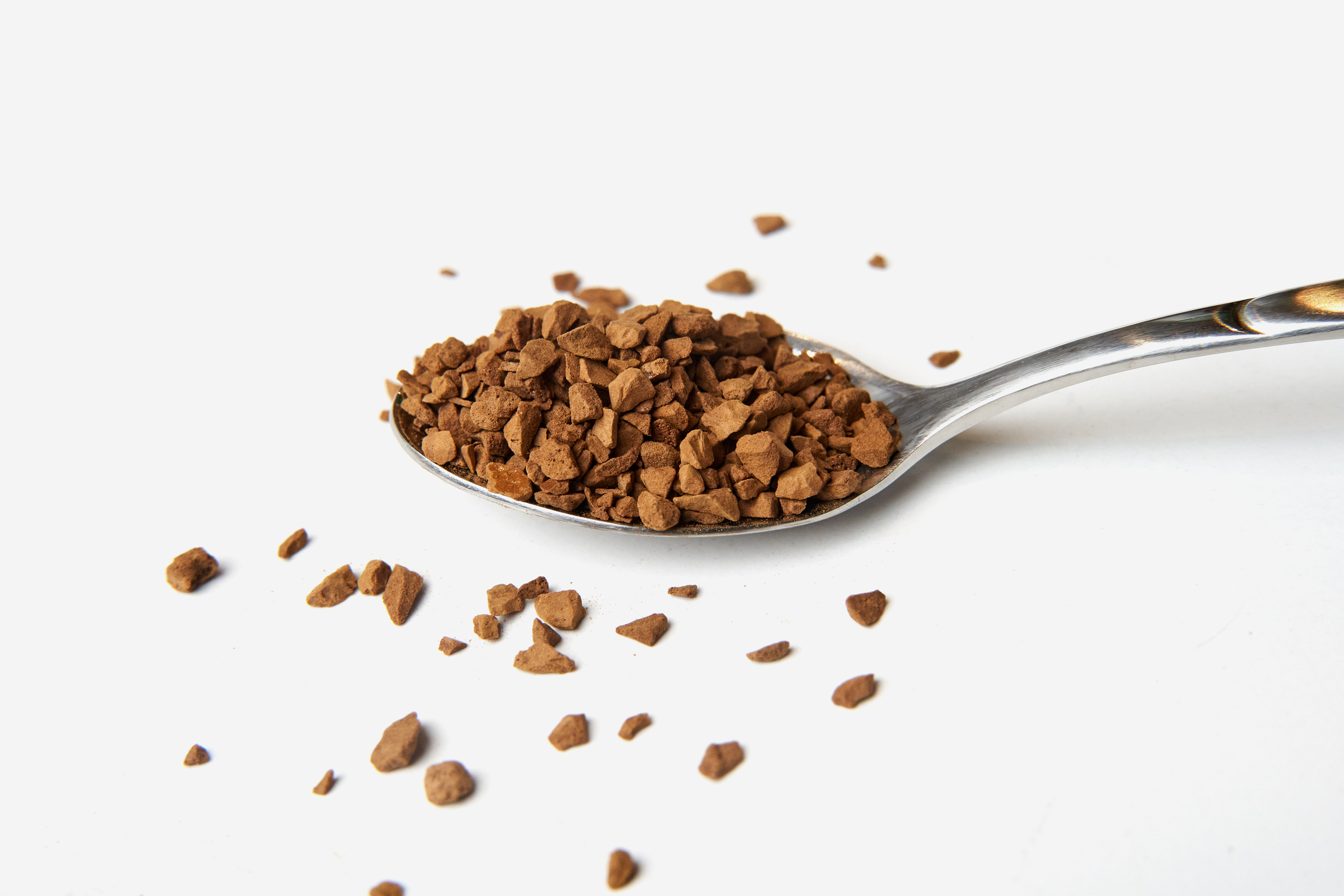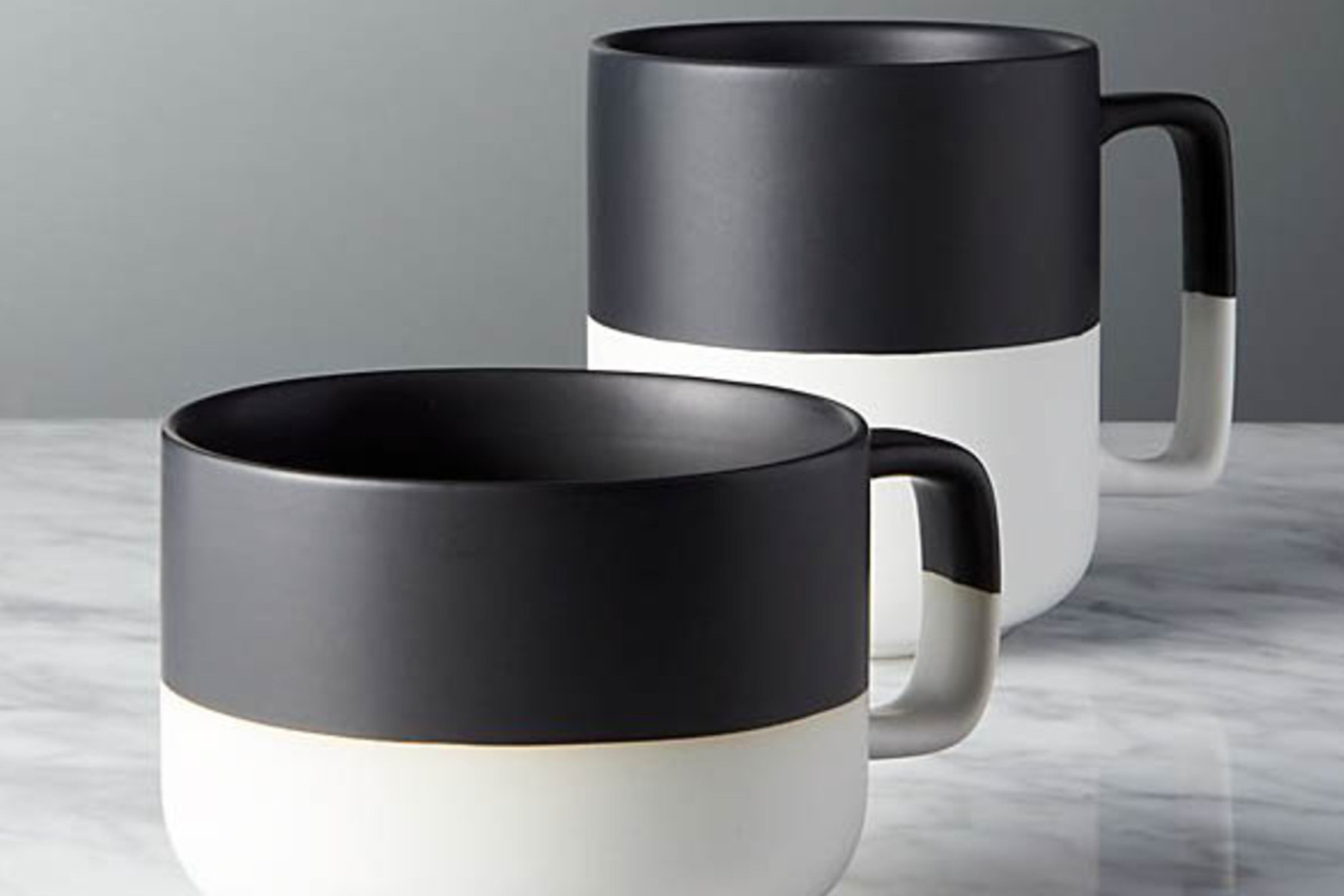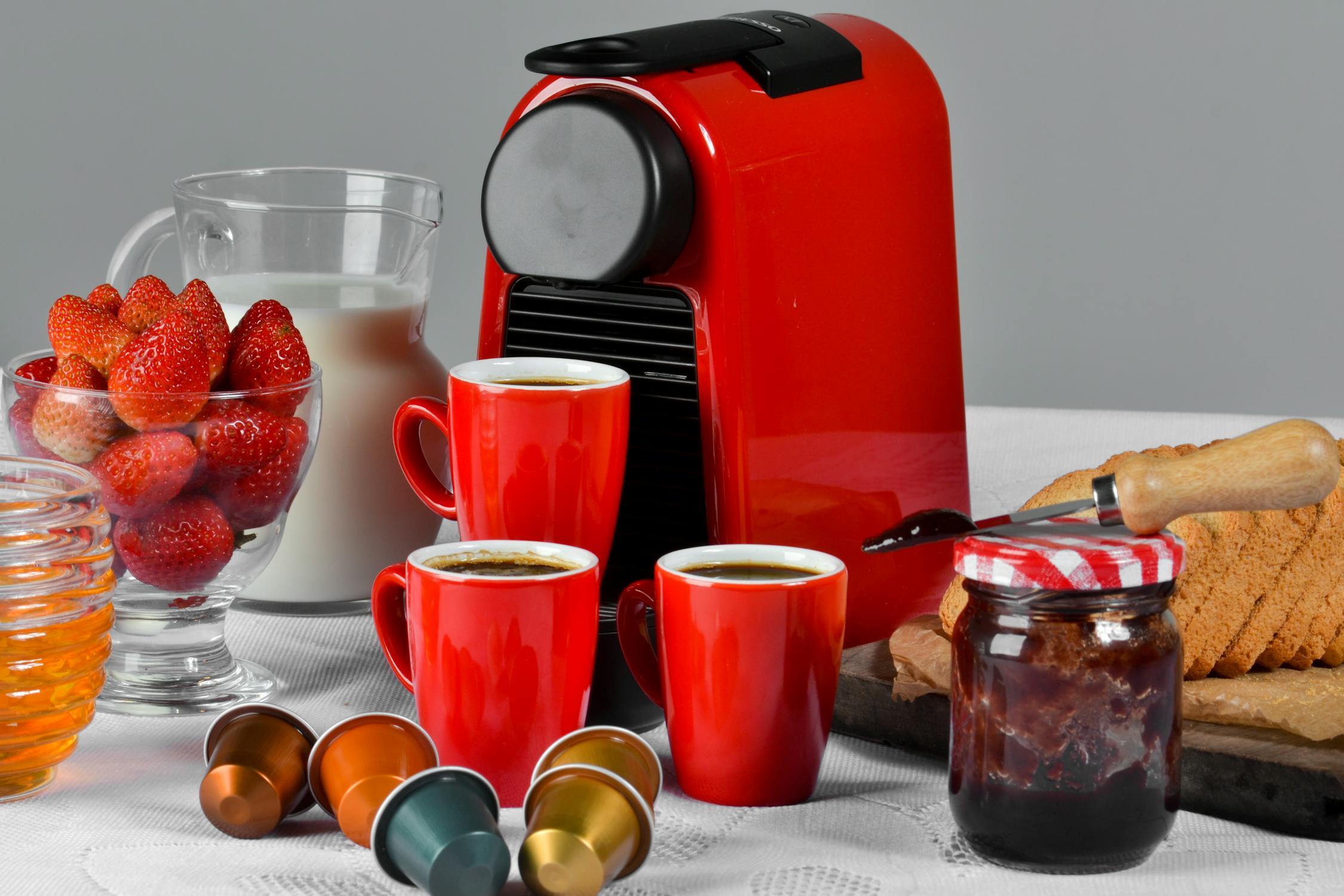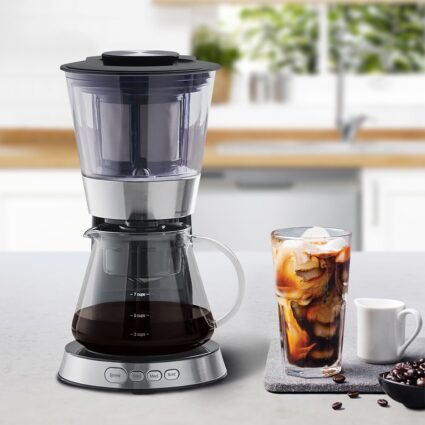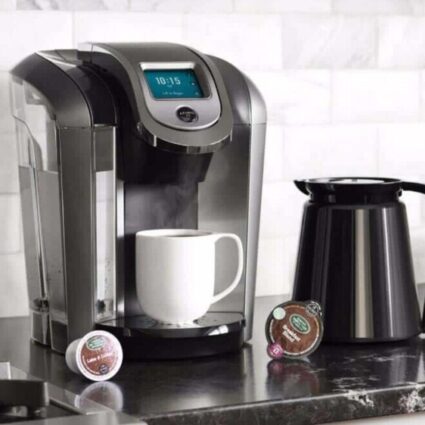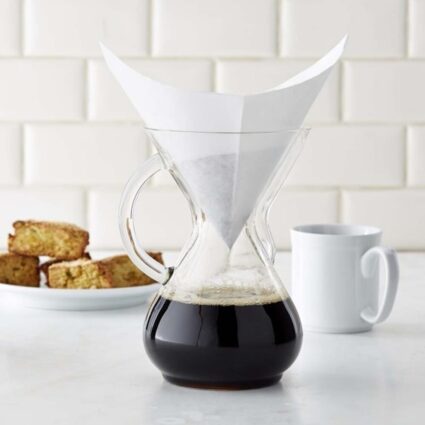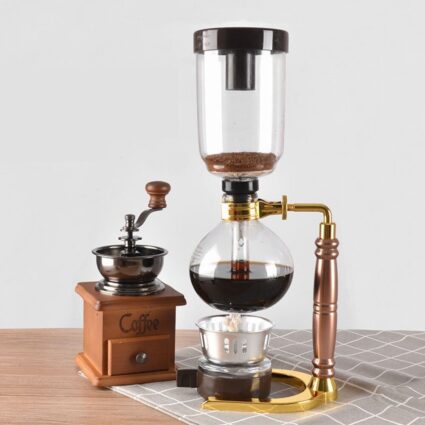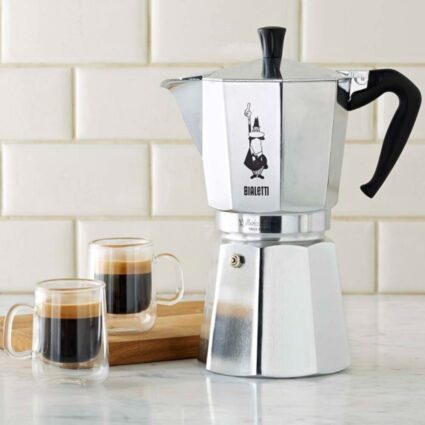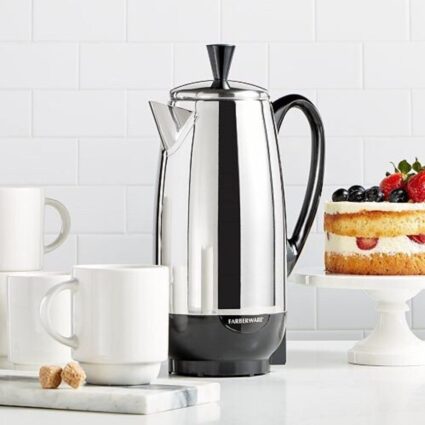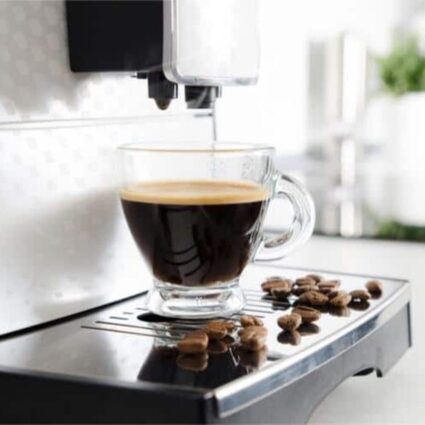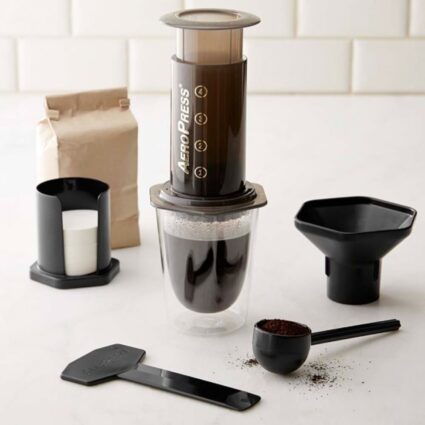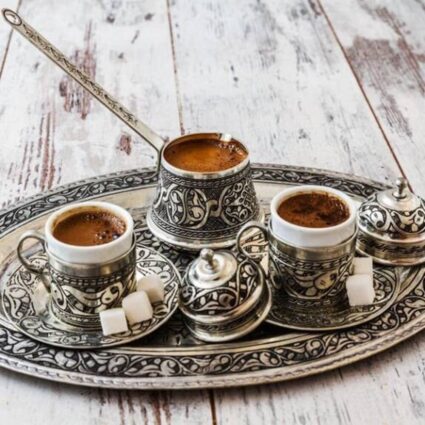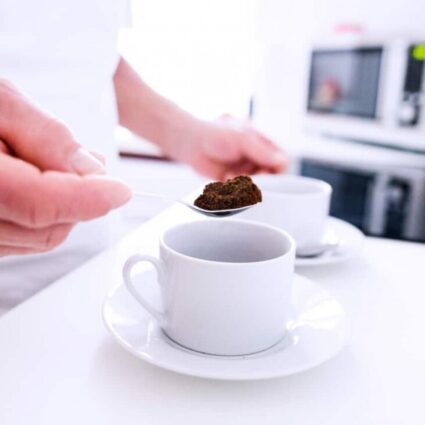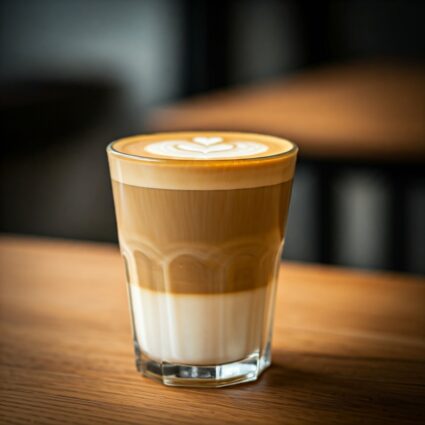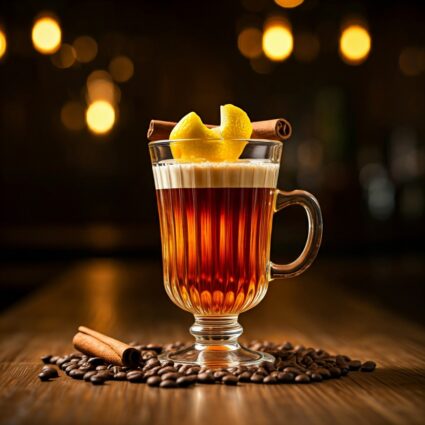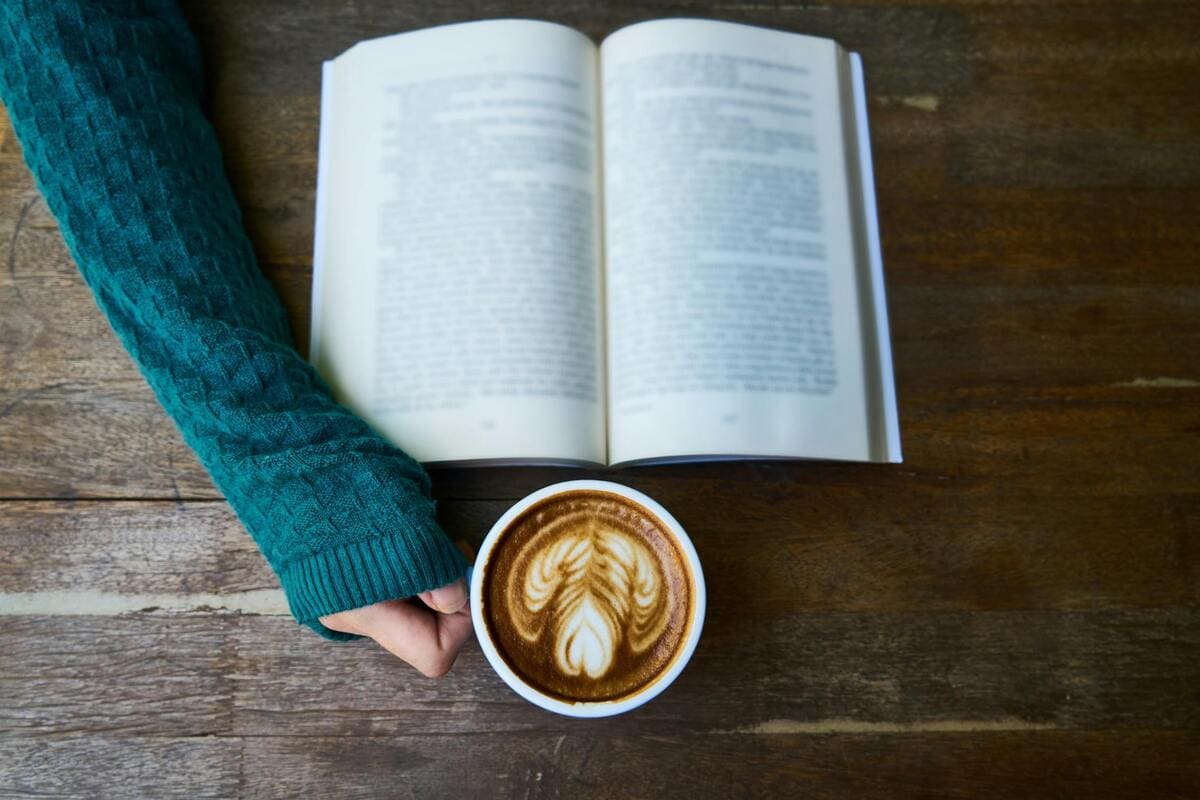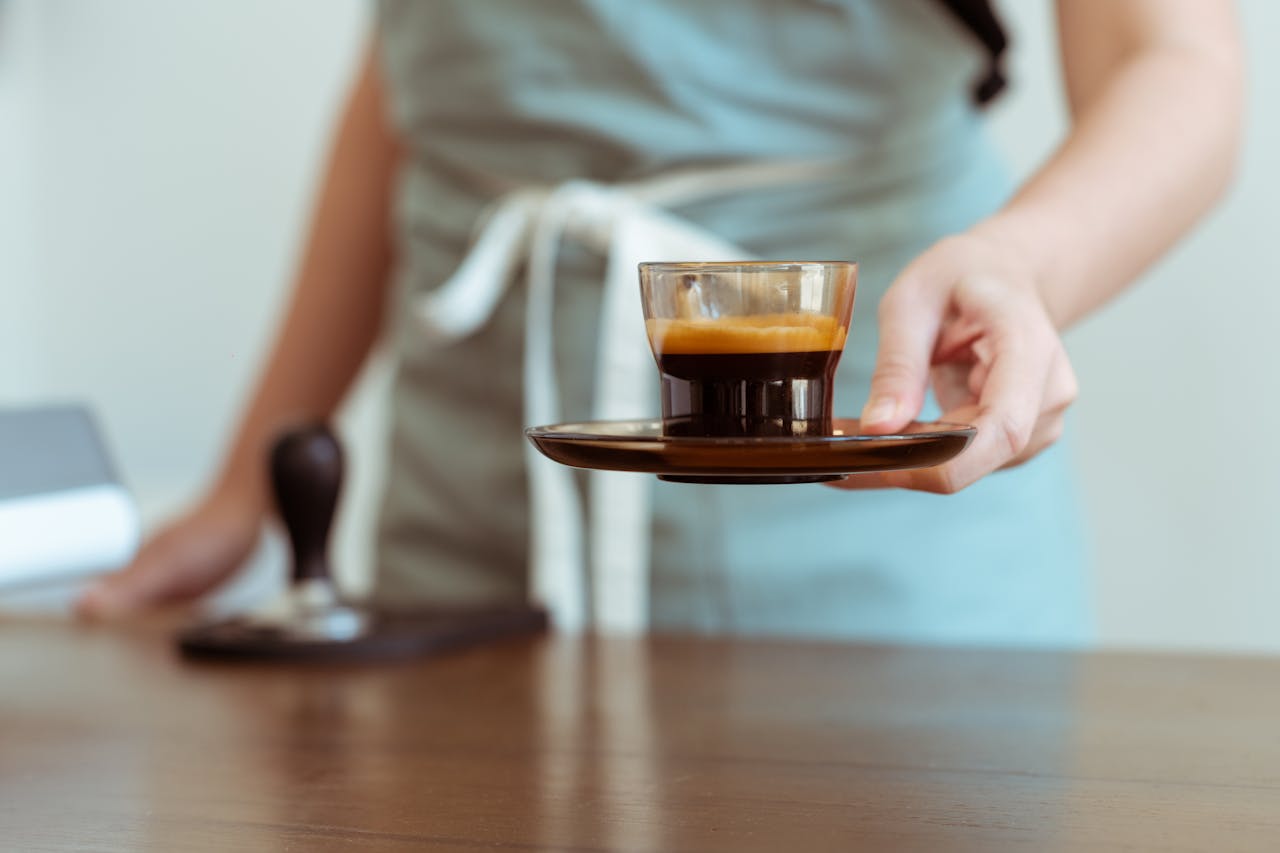A
AA – Grading term referring to beans of a specific, larger than normal size. Most commonly used for Kenyan coffees.
Acidity – Not to be confused with bitterness, acidity refers to the pleasant tartness and brightness that’s present in high-quality coffee. Without acidity, coffee will lack complexity and fall rather flat.
AeroPress – a single-serve manual coffee brewer, invented by Alan Adler. Cylindrical in shape, the AeroPress coffee maker features a brewing chamber and a plunger with a silicone seal. After ground coffee has steeped in water for the desired time, it’s forced through a paper filter using the plunger. One of my favorite brewing methods!
Affogato – Translates to “drowned” in Italian. In its traditional form, affogato al caffé involves pouring hot espresso over a scoop of vanilla ice cream or gelato. In case you’ve never tried an affogato, yes it’s as delicious as it sounds.
Aged Coffee – Green (unroasted) coffee that’s carefully stored in warehouses for anywhere from a few months to several years. When aged properly, these coffees demonstrate reduced acidity and increased body.
Americano – Popular beverage consisting of one or two shots of espresso diluted with hot water that’s poured into the espresso. Legend has it the caffé americano originated in Italy during the Second World War, as a way to make espresso more palatable to American GIs.
American Roast – A light-medium roast profile that’s traditionally been the preferred roast in North America. Also known as City Roast or Breakfast Roast.
Anaerobic Fermentation – Style of coffee fermentation in which freshly harvested coffee is fermented in steel tanks with reduced oxygen. This encourages the formation of lactic acid and suppresses the formation of yeast.
Aquapulp – Coffee processing term, referring to the method of removing a freshly picked coffee cherry’s pulp, or mucilage, using specially designed machines.
Arabica – Widely regarded as the first species of coffee to be cultivated, Arabica accounts for 70 percent of the world’s coffee production. Arabica is vastly superior in cup quality to the other main commercially cultivated species of coffee, Robusta. However, Arabica is more susceptible to disease and infestation and only thrives at high elevations.
Aroma – Refers to the smell of brewed coffee. Is there a better smell in the known universe? Coffee’s aroma is closely related to how it tastes, allowing us to discern many of the complex nuances present in a cup of coffee.
B
Balance – Used as a tasting term to describe the way in which acidity, body and mouthfeel compliment each other and work to increase complexity in the cup.
Barista – Italian for bartender. A barista is a coffee professional skilled in espresso preparation, milk steaming and customer service, along with a great many other things. Show your barista the respect they deserve and always leave a tip!
Batch Roaster – A coffee roaster that produces one batch of coffee at a time. The roasted coffee must be removed before another batch can be roasted.
Bird Friendly – Certification for coffee that has been cultivated according to criteria established by the Smithsonian Institute. To gain certification, producers must first meet the requirements for organic certification. Additional requirements involve meeting criteria for maintaining sufficient forest cover to provide habitats for birds and other wildlife.
Bitter – A taste sensation that’s detected on the back of the tongue. While some amount of bitterness is acceptable in a well-balanced cup of coffee, an over-extracted cup will be unpleasantly bitter.
Black Eye – Not for the faint of heart, a black eye is a cup of coffee with the addition of a double shot of espresso.
Blade Grinder – A small, inexpensive home coffee grinder that uses a spinning stainless steel blade to “chop” coffee beans. The resulting grind size will be quite inconsistent, especially compared to a burr grinder.
Blend – A mix of two or more types of single-origin coffees. Coffee can be blended before or after roasting. The aim is to create a complex coffee blend that’s a sum of its constituent parts.
Bloom – The blooming process involves slowly pouring a small amount of hot water onto a bed of ground coffee. This allows the carbon dioxide that built up during the roasting process to escape. Blooming is the first stage of preparing coffee in a pour over dripper, Chemex and French press.
Body – A tasting term used to describe brewed coffee’s texture and how it feels in the mouth. Common examples include full-bodied, heavy, syrupy and thin.
Bourbon – An heirloom cultivar of the Arabica species, Bourbon was discovered on the island of Réunion, formally known as Île Bourbon. This cultivar produces a medium yield when compared with other cultivars and grows best at elevations of between 1,000 and 2,000 meters above sea level.
Breve – Essentially, breve coffee is a latte made with steamed half and half.
Brew Ratio – The ratio of ground coffee to water when brewing. Although highly subjective, a generally accepted rule of thumb is to use a 1:18 ratio of ground coffee to water.
Brew Temperature – A vital parameter in coffee preparation, brew temperature refers to the temperature of the water used to brew coffee. According to the National Coffee Association, water temperature should be between 195 and 205 degrees Fahrenheit (90 and 93 Celsius) for optimal extraction.
Brew Time – The amount of time that ground coffee is in contact with water. Each brewing method has its own optimal brew time, ranging from less than 30 seconds for espresso to 12 hours or more for cold brew coffee.
Briny – Used to describe the salty taste you’ll find in truck stop coffee that’s been sitting on a hot plate for hours. Coffee with a briny taste is also a sign of over-extraction.
Bright – Used in coffee tasting to describe perceived acidity. A common feature of washed coffees from Kenya, Ethiopia and Rwanda.
Burr Grinder – Widely considered to be the best coffee grinder for obtaining consistent results, a burr grinder features a pair of rotating burrs through which whole coffee beans are ground. Burrs can be either conical or flat, with arguments for and against each shape.
C
Cafe Au Lait – Equal parts brewed coffee and hot milk, cafe au lait is a French coffee most commonly enjoyed at breakfast time. Also found in many other countries including Spain (café con leche) and Germany (milchkaffee).
Caffeine – The world’s most popular drug, caffeine produces stimulating effects on the brain and nervous system of animals. Caffeine is present in tea, coffee and cacao plants.
Cappuccino – Hailing from Italy, the cappuccino can now be found all over the world. A traditional cappuccino is served in a 6-ounce cup and consists of equal parts espresso, steamed milk and milk foam.
Cascara – The dried outer fruit or cherry of a coffee bean, cascara is Spanish for “shell” or “husk.” Cascara can be brewed into a tea which exhibits a floral, sweet and fruity flavor profile.
Caturra – A modern Arabica hybrid, Caturra has grown in popularity among farmers, thanks to its higher yields and improved disease resistance when compared to Bourbon and Typica cultivars.
Chaff – Fine, papery skin on green coffee beans that’s released during the roasting process.
Chemex – Invented by Peter Schlumbohm in 1941, the Chemex is a manual pour-over coffee maker that produces exceptionally clean coffee thanks to its proprietary paper filter. Featuring a distinctive borosilicate glass flask that’s fastened with a wood collar and tie, the Chemex is available in several different sizes.
Clever Dripper – A single-cup immersion brewer that also employs aspects of a pour-over dripper. Ground coffee steeps in hot water inside the device and is released and filtered through paper once the Clever Coffee Dripper is placed on a cup.
Clover Brewer – A single-cup coffee machine that uses VaccumPress technology to produce exceptionally clean coffee. The Clover was originally developed by Seattle-based Coffee Equipment Company, which was acquired by Starbucks in 2008.
Coffee Bean – A coffee bean is actually the seed of the coffea plant, found inside the fruit or cherry. There are usually two seeds in each cherry, with their flat sides together. If only one seed is fertilized, it develops into a peaberry.
Coffee Cherry – Term used to describe the fruit of the coffee tree. Coffee cherries are often bright red when ripe, but can also be pink or yellow. Each coffee cherry contains two seeds, also called coffee beans.
Cold Brew – An immersion brewing method in which coarsely ground coffee is steeped in cold or room temperature water for several hours. The resulting cold brew concentrate is then filtered and can last for several weeks in the refrigerator. Cold brewing produces a light, sweet and low-acid coffee.
Complexity – A tasting term used to describe layers of flavor in coffee and the way they change and interact with each other.
Con Panna – Espresso con panna means “espresso with cream” in Italian. Order a con panna, and you’ll get a single or double shot of espresso topped with whipped cream.
Conniption – The best word to describe the state of mind you’ll be in if you can’t figure out how to get a new coffee maker or super automatic espresso machine working before the caffeine in your bloodstream is completely depleted.
Conniption Fit – the disturbing behavior innocent bystanders witnessed you display when you woke up and realized someone had broken your super automatic espresso machine.
Continuous Roaster – A large industrial roaster that produces coffee continuously rather than in batches.
Cortado – A small beverage consisting of equal parts espresso and steamed milk. Originating in Spain, cortado translates as “cut” and refers to the sweetness of the milk cutting the strong coffee.
Crema – An integral part of well-extracted espresso, crema is the brown, aerated foam that’s characteristic of this type of coffee. Created when air bubbles combine with coffee’s soluble oils under pressure, crema contains aromatic compounds that linger on the palate for hours.
Cup of Excellence – An annual cupping competition that’s held in several countries. Producers submit their best coffee in the hope that it will score highly, therefore commanding a higher price at auction.
Cupping – The process by which coffee professionals evaluate coffee. Hot water is added to coarsely ground coffee in small cups. The liquid is sampled by slurping it from a spoon to spray the palate, and is evaluated when hot and as it cools. Cupping scores are given, based on criteria such as body, acidity and complexity.
D
Dark Roast – A fairly broad term to describe coffee beans that have been roasted beyond medium. Dark roasted coffee beans are more full-bodied and less acidic than those with a medium roast profile and also contain less caffeine. Some say dark roast coffee tastes burnt, whereas others enjoy the bittersweet, smoky flavor. Different strokes for different folks!
Dead as a Doornail – Phrase used to describe the state of your 20 year old coffee maker that, unfortunately, must be replaced.
Decaffeinated – Coffee that’s had at least 97 percent of its caffeine removed can be referred to as decaffeinated or decaf. Decaffeination can be achieved through either a chemical process, water process or carbon dioxide process, and is always performed on green (unroasted) coffee.
Degassing – Occurs naturally in freshly roasted coffee. During the roasting process, carbon dioxide builds up in the coffee beans. This is slowly released over a period of days, temporarily averting the oxidation process.
Depulper – A machine used in coffee processing that strips the outer skin and flesh from the coffee seeds before fermentation. Depulpers can be hand-operated or mechanized.
Dry Processed Coffee – Also called natural process, freshly harvested ripe coffee cherries are left to dry in the sun for a period of around two weeks. The dried skin, pulp and parchment are then removed. Dry processed coffee is known for its low acidity and full body, as well as a distinctly fruity flavor profile. The most highly prized dry processed coffees come from Ethiopia, Yemen and Brazil.
Ding Dong – Someone who thinks all coffee tastes the same or believes espresso is spelled with an x.
Direct Trade – Term used by coffee roasters who purchase coffee directly from farmers. This cuts out the traditional middlemen, allowing farmers to get a much better price for their crop. Also known as relationship coffee, roasters and farmers often develop long-term, mutually beneficial partnerships. Roasters have more input on coffee quality, and farmers know they’ll be able to sell their product at a good price each year.
Doohickey – A small gadget every home barista knows they need, but has no idea what is or can’t remember what is called.
Doppio – A double espresso clocking in at around three ounces.
Doser – Found on coffee grinders designed for use with espresso, a doser is a spring-loaded device that dispenses a pre-set amount of ground coffee into the portafilter.
Drip Coffee Maker – Probably the most popular way to prepare coffee, drip coffee makers range from simple, affordable machines to high-tech, precision brewers. They all use essentially the same method, though – hot water drips slowly through a bed of ground coffee, and filtered into a carafe or other vessel.
Drip Tray – Found on espresso machines and super automatics, the drip tray sits under the portafilter and collects any spills that may occur.
E
Earthy – A taste characteristic most commonly found in semi-washed coffees from Indonesia. Used to describe an aroma of wet soil or earth, it can be used positively or negatively, depending on how it sits in a given coffee’s overall flavor profile.
Espresso – A popular brewing method in which hot water is forced under a minimum of nine bar of pressure through a bed of compressed, finely ground coffee. The Italians have done a lot for humanity, but espresso has to be up there among their greatest gifts. Whether or not it ranks above pizza and the Lancia Delta Integrale is up for debate. Either way, the world would be a much sadder place without this rich, powerful version of coffee. Grazie mille!
Estate-Grown – Refers to single-origin coffee that has been grown on a specific farm or group of farms that all share the same mill. In general, estate-grown coffees have been subject to higher standards of quality control than multi-lot coffees and thus command higher prices.
Extraction – This is how you get the goods. Extraction is the process of obtaining desirable compounds and caffeine by combining ground coffee beans and hot or cold water. This can be achieved under pressure or through full immersion.
F
Fair Trade Coffee – A group of international agencies sets a “fair” price for coffee, supposedly guaranteeing farmers a sustainable income from their product. Producers who grow fair trade certified coffee must also invest in community development, ensure safety standards and avoid the use of harmful chemicals and other environmentally damaging practices.
Fermentation – An important part of the wet or washed process. After freshly harvested coffee has been depulped, the seeds are left to ferment in an open tank (aerobic) or closed tank (anaerobic) for up to 72 hours. The idea is to break down the remaining sticky mucilage from the beans before they’re rinsed then dried.
Filter – Any porous “screen” that allows liquid coffee to pass while retaining as much solid matter as possible. The best coffee filters are usually paper or metal, but can also be made from nylon or cloth.
Finish – When you’ve taken a sip of coffee and swallowed, the good (or bad) flavors linger and continue to develop. That’s the coffee’s finish. A delicious and well-extracted espresso will have a long finish that’ll just keep giving. Yum!
First Crack – An important stage in the coffee roasting process. As the coffee bean is heated, moisture starts to evaporate, creating steam. The resulting buildup of pressure causes the bean to crack open with a sound like popping popcorn. First crack occurs at around 385 degrees Fahrenheit (196 degrees Celsius) and alerts the roaster to the fact that the coffee is almost at the light roast stage.
Flat White – Originating in either Australia or New Zealand, the flat white is a popular milk-based drink featuring one or two shots of espresso and finely textured microfoam. Although similar to a latte, the flat white is usually smaller in volume.
Fragrance – Term used in specialty coffee evaluation to describe the aroma of freshly ground coffee before it’s been brewed.
French Press – Both a brewing method and a brewing apparatus. French press uses the immersion process to steep coarsely ground coffee in hot water. Brewing is completed by pressing the coffee grounds to the bottom of the pot using a plunger with a mesh filter.
G
Geisha – A variety of Arabica, Geisha coffee is thought to have originated in the Gori Gesha forest of Ethiopia. The varietal first rose to international prominence in 2004, when a Geisha offering from Hacienda La Esmeralda won the Best of Panama competition.
Green Coffee – Unroasted coffee beans.
Group Head – A protruding fixture on the front of an espresso machine, the group head is where the portafilter with its coffee puck is inserted. The group head acts as the interface between the inner workings of the espresso machine and the barista. It contains a water line coming directly from the boiler and a mesh filter screen, which helps distribute hot water over the ground coffee.
H
Hard Bean – Refers to specialty coffee grown at high elevations — 4,000 feet (1,219 meters) above sea level or more. Coffee grown at higher elevations produces a fruit that’s slower to ripen and with a more even balance between sugars and acids. The beans themselves will be harder and less porous than those grown at lower elevations.
High-Grown – Refers to Arabica coffee that’s been cultivated at elevations above 3,000 feet (914 meters). It’s generally accepted that high-grown coffee is of a superior quality to that which is cultivated below the elevation threshold.
Honey Process – Also known as pulped natural, the honey process involves depulping freshly harvested coffee cherries, then leaving the beans to dry without removing the mucilage. Thanks to its amber color, this sticky outer layer is reminiscent of honey, hence the name.
Hulling – Once coffee beans have been processed and dried, a papery skin known as parchment or pergamino remains. Hulling is the process of removing the parchment, using machines that also polish the green coffee beans.
I
Ibrik – Also called a cezve, this is a long-handled pot used to prepare Turkish coffee. Usually made from copper, an ibrik can also be made from stainless steel, ceramic or silver. Stainless steel ibriks also make great pitchers for heating and frothing milk.
Immersion Brewing – Describes any manual preparation method in which ground coffee is immersed in water, eg. French press, cold brew.
J
Joe – slang term for coffee, most often used in North America. Read more about the history behind the name here.
Jitters – A word used to describe the feeling one gets when they’ve either had too much caffeine or are in the midst of a caffeine crash because the stimulant has worn off.
K
Kalita Wave – Pour over coffee maker with a flat bottom design and three holes for extraction. Uses patented “Wave” paper filters.
Kopi Luwak – Produced in Sumatra and one of the most expensive coffees in the world. Kopi luwak is Indonesian coffee that’s been eaten and partially digested by the civet, a nocturnal mammal found in the island’s jungles. Unfortunately, as kopi luwak has become more popular, it has become less of a wild harvested product and more likely to come from caged civets that are extremely maltreated.
L
Latte – Milk-based espresso drink, consisting of 1 or more shots of espresso, steamed milk and milk foam. Can also be served over ice with cold milk and espresso.
Light Roast – Broad term to describe coffee that’s been roasted until just after second crack. Light roast coffee is light brown in color and has no surface oils. This type of roast is ideal for showcasing a specialty coffee’s unique flavor profile.
Long Black – originating in Oceania and almost indistinguishable from an americano, a long black is one or two shots of espresso poured into a cup of hot water.
Lungo – an extra-long shot of espresso. Lungo is Italian for “long,” which makes sense when you think about it!
M
Macchiato – Italian for “stained,” the macchiato can cause a lot of confusion. That’s because there are two types of macchiato – a latte macchiato and an espresso macchiato. A latte macchiato involves a small amount of espresso “staining” the top of a large glass of hot milk, while an espresso macchiato is a shot of espresso “stained” by a small amount of milk foam.
Machine Drying – No matter how coffee is processed, it needs to be dried at some stage. Machine drying uses large mechanized drums to dry coffee beans after the fruit has been removed. In most cases, machine drying is used as an extra drying stage after coffee has been sun-dried.
Maragogipe – Also called Elephant Bean, this is an Arabica varietal that was first identified in Brazil. Although Maragogype beans are on the larger side, the plants are notorious for their low yields.
Medium Roast – Also known as American Roast. Coffee that’s been roasted to a medium brown color, just beyond second crack. Unlike light roast, there’s less “transparency” in a medium roast coffee, as some of the taste from the roasting process will be in evidence.
Micro-Lot Coffee – Coffee beans that can be directly traced to a single farm or small section of a single farm.
Mocha – Either a beverage combining espresso, steamed milk and chocolate, or a single-origin coffee from Yemen. Also known as Arabian Mocha, this is the oldest-known cultivated coffee, named after the port of Mocha on the Red Sea coast of Yemen.
Moka Pot – An Italian brewing apparatus comprising an upper and lower chamber, usually made from aluminum or stainless steel. Traditionally, the moka pot was a stovetop device, although electric models are now widely available. As water in the lower chamber is heated, steam is generated, forcing water under pressure through a bed of finely ground coffee and into the upper chamber.
Monsooned Coffee – Traditionally, Indian coffee had to sit until monsoon season was over, before being shipped to Europe. Windy conditions dried the coffee beans, reducing acidity and increasing body, resulting in cup qualities that were seen as desirable. Today, Indian coffee is deliberately monsooned by being stored in open warehouses and exposed to seasonal winds.
Mucilage – Sticky, sugary layer surrounding coffee seeds.
N
Natural Process – Also known as Dry Process or Dry Method, natural processed coffees are dried with the outer layers intact. This imparts a distinctly fruity and complex flavor profile, celebrated in coffees from Yemen, Harrar in Ethiopia and Brazil.
New Crop – Coffee that’s been roasted as soon after harvesting and processing as possible. New crop coffee is noted for its freshness and brightness.
O
Old Crop – Coffee that has been held in warehouses for some time before delivery to roasters. What’s important to note is that old crop coffee can often display a superior cup quality to the new crop of the same lot.
Organic Coffee – Coffee that’s been certified by a third party as having been cultivated without the use of chemicals. It’s important to note that farmers often have to pay a lot of money and deal with a lot of red tape to get the organic certification. So, just because a coffee isn’t certified organic doesn’t mean it hasn’t been grown without the use of chemicals.
Over-Extraction – A coffee term that explains what happens when ground coffee is in contact with water for too long, thus extracting more flavor from the coffee grinds than is palatable.
P
Pacamara – A hybrid Arabica varietal, Pacamara is a cross between Maragogype and Pacas varietals, and was first created by the Salvadoran Institute for Coffee Research in 1958. Pacamara combines the best qualities of both varietals – the sturdiness, disease resistance and high yield of Pacas with the large bean size and sublime cup quality of Maragogype.
Parchment – Also known as pergamino, this is a thin, papery substance that covers washed process coffee beans after they’ve been depulped, washed and dried.
Patio Drying – The process of sun-drying coffee before hulling (natural process) or after washing (wet process). The coffee is laid out on raised beds and raked and spread in thin layers. Depending on weather conditions, time of day and other factors, the patios may or may not be covered.
Peaberry – A natural mutation that causes only one seed to develop inside a coffee cherry. Peaberries are often separated into their own lot and are prized for their well-balanced, fruit-forward acidity.
Perkatory – The period of waiting to buy more coffee beans until you’ve finished what you already have.
Percolator – A coffee brewing device resembling a kettle, the percolator predates drip coffee makers yet still remains popular. Available as an electric or stovetop device, the percolator uses gravity to continuously cycle boiling water through a bed of ground coffee. Commonly used to prepare cowboy coffee. Yeehaw!
Phin – A pour over device used in Vietnam to produce strong, concentrated coffee. Phin is the Vietnamese word for filter.
Piston Machine – A manual espresso machine that requires the operator to pump a lever in order to create the necessary pressure to force hot water through the espresso puck.
Potato Taste Defect – Most commonly occurring in coffee from Rwanda, Democratic Republic of Congo, Burundi and Uganda, Potato Taste Defect (PTD) results from bacteria entering a coffee cherry through a lesion in the fruit’s skin. Often caused by a burrowing beetle, the defect goes unnoticed until roasted coffee is ground. It only takes one bean with PTD to ruin a batch of ground coffee by creating the odor and taste of raw potato.
Portafilter – Comprising a plastic handle and a removable metal basket filter, the portafilter holds tamped coffee grounds and fits tightly into the group head. The portafilter often has one or two spouts below the basket filter through which espresso runs during brewing. That said, “bottomless” portafilters are now very common and often preferred by baristas.
Pour Over – Manual brewing method involving slowly adding hot water to a bed of ground coffee, often in several stages. Pour over drippers vary in shape and materials used and always require a filter. The filter is often paper, although metal or nylon filters are also common.
Puck – So-called because it resembles a hockey puck, this is the compressed disc of ground coffee left in the portafilter after espresso preparation.
Pull – Used to describe the act of extracting espresso. In the good old days, all espresso machines were manual, with the barista pulling a lever to extract espresso.
Pulped Natural Process – See Honey Process
Q
Q Grader – A licensed professional who has been certified to assess and score roasted coffee according to a set of standards developed by the Specialty Coffee Association (SCA).
Quakers – Defective coffee beans that can’t be roasted properly.
R
Red Eye – See Blackeye.
Relationship Coffee – Considered by many roasters to be a superior alternative to the Fair Trade model, Relationship Coffee involves a long-term trading partnership between roaster and producer. Building relationships benefits both parties – the farmer is insulated from market fluctuations and has more bargaining power, while the roaster has more input when it comes to developing coffee quality and consistency.
Ristretto – Meaning “restricted” in Italian, a ristretto is a shot of espresso that’s pulled short. In general, a ristretto espresso should have a shot volume of around 25 milliliters (0.85 ounces), with an extraction time of no more than 25 seconds.
Roasting – The process by which raw green coffee beans are turned into palatable coffee for consumption. The roasting process uses heat to chemically and physically alter the green coffee, resulting in beans that are pleasantly caramelized and complex.
Robusta – More resilient than Arabica, Robusta thrives at lower altitudes and produces a higher yield. Although Robusta’s quality is vastly inferior to that of Arabica, the full-bodied coffee it produces is often used in espresso blends. Currently, Robusta accounts for around 30 percent of coffee production worldwide.
S
SCA – Founded in 1982, the Specialty Coffee Association (SCA) is a non-profit organization representing coffee professionals all over the world.
Second Crack – An important stage in the coffee roasting process. Less audible than the popping noise heard during first crack, this milestone alerts the roaster to the fact that the coffee beans are beginning to take on roast flavors, and that oils from within the beans are beginning to move to the surface.
Semi-Washed Coffee – See Honey Process
Shade Grown – Coffee marketed as “Shade Grown” has been produced under a mixed canopy of trees. This has been the traditional way of growing coffee in many parts of the world. See also: Bird Friendly.
Short Black – Australian term for a shot of espresso.
Shot – Used to describe a single serving of espresso.
Silverskin – Thin, papery skin attached to coffee seeds. Can be removed by polishing, but usually remains until it floats free during roasting. See Chaff.
Single-Origin Coffee – Used to describe coffee that can be reliably traced to a single producer, farm or region within a specific country.
Siphon Coffee Maker – Also known as a vacuum pot, this brewing apparatus was invented in Germany in the late 19th century. Similar to a moka pot, the siphon coffee maker uses steam pressure and gravity to brew coffee.
Soft Bean – Used to classify coffee beans grown at low elevations. In contrast to Hard Bean coffee, the fruit ripens more quickly, usually resulting in softer beans and a less complex cup profile.
Sorting – One of the final stages of coffee processing, sorting can be done by hand, machine or a combination of both. Coffee is sorted according to a set of criteria that may include size, color and density.
Specialty Coffee – Term used to describe the highest quality coffee available. Specialty coffee has been properly processed and sorted and must be free of primary defects. It represents just 10 percent of global coffee production.
Steam Wand – A thin metal tube protruding from the side of an espresso machine. The steam wand is connected to the machine’s internal boiler, and allows the user to create milk foam using a pressurized jet of hot steam.
Sun Drying – The traditional method of drying coffee beans, sun drying is still a widely used method. Coffee is laid out in thin layers on raised beds or patios, then raked from time to time to ensure even drying. Depending on weather conditions or time of day, the coffee will be shaded. See also: Patio Drying.
Super Automatic Espresso Machine – A fully automated coffee machine designed to make a variety of coffee drinks at the push of a button. Super automatics feature built-in grinders and automated milk frothing systems.
Swiss Water Process – A chemical-free decaffeination process that uses water to remove caffeine from green coffee beans. Originating in Switzerland in the 1930s, the company responsible for this trademarked decaffeination method is now headquartered in British Columbia.
T
Tamper – Tool used in espresso preparation to pack or tamp ground coffee in a portafilter’s brew basket. An espresso tamper can be manual, automatic or dynamometric.
Terroir – Refers to the effects of climate, soil and geographic location (among other factors) on a coffee’s flavor profile. A coffee with terroir is completely unique and can’t be reproduced anywhere else.
Thermal Block – Also known as a thermoblock or thermocoil. A thermal block is a metal device that heats water quickly, eliminating the need to wait for a boiler to heat water. A common feature of home espresso machines, thermal blocks are convenient but notoriously inconsistent.
Thingamabob – Most often used before caffeine reaches the bloodstream, to describe a much needed object that you need to inform or explain to someone about in order to make coffee.
Thingamajig – That coffee making tool you’ve used a thousand times but can’t remember the name of or can’t locate for the life of you. Usually used in reference to portafilters, coffee grinders and coffee scoops.
Turkish Coffee – Method of coffee preparation in which very finely ground coffee is boiled in water. Turkish coffee is made in an ibrik or Turkish coffee pot and served unfiltered.
Typica – One of the oldest and most highly regarded of the Arabica varieties. Typica is characterized by its cold hardiness and exceptional cup quality. The downside of cultivating Typica is its relatively low yield and susceptibility to disease.
U
Unbelievable – An exclamation of excitement that frequently gets used the first time someone tastes coffee made with freshly roasted coffee beans.
Under-Extraction – A coffee term that describes what happens when coffee grinds and water don’t have enough time to interact, hence less flavor is present in the coffee.
V
V60 – Pour over coffee dripper produced by Japanese company Hario. The V60 features a conical shape and uses paper filters. One of the most popular manual drippers, the Hario V60 is available in copper, glass, stainless steel, porcelain and plastic.
Vacuum Pot – See Siphon Coffee Maker.
Varietal – Term used to describe a single botanical variety of coffee plant, for example Bourbon, Typica or Geisha.
W
Washed Coffee – Coffee that has been processed using the washed method. As soon as the coffee has been harvested, the outer cherry is removed and the seeds are fermented before being washed and dried.
Washing Station – Also called a wet mill. This is where freshly picked coffee cherries are brought to be washed and depulped if they’re to be processed using the washed method. A washing station can be as simple as a tub of water and a manual depulper, or an extremely complex and sophisticated affair.
Whatchamacallit – Used to refer to a home barista tool you can’t remember the name of. Often employed while trying to convince a friend or family member how badly they need one, and how having one will greatly improve the quality of their coffee.
X
Xpresso – A slang term for or misspelling of espresso.
Xylitol – A sugar alternative made from birch trees or corn stalks that some people use in their coffee. It has a lower glycemic index than sugar.
Y
Yawn – The action your body takes to pull more oxygen in to achieve alertness when your most recent dose of caffeine is wearing off. Known for its contagious effect on those around you, it’s best remedied with sleep or a cup of coffee with a preference toward the latter.
Yuck – An exclamation of disgust, most appropriately used when tasting k cup coffee, which is notoriously stale and lacking in flavor.
Z
Zombie – Someone who looks like the walking dead because they haven’t had their coffee yet.
Zone Out – What the mind tends to do without sufficient caffeine, especially when someone won’t stop talking in your presence.
